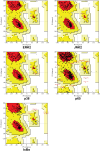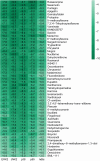Screening potential anti-osteoarthritis compounds using molecular docking based on MAPK and NFκB pathways and validating their anti-osteoarthritis effect
- PMID: 40131994
- PMCID: PMC11936181
- DOI: 10.1371/journal.pone.0319686
Screening potential anti-osteoarthritis compounds using molecular docking based on MAPK and NFκB pathways and validating their anti-osteoarthritis effect
Erratum in
-
Correction: Screening potential anti-osteoarthritis compounds using molecular docking based on MAPK and NFκB pathways and validating their anti-osteoarthritis effect.PLoS One. 2025 May 14;20(5):e0324192. doi: 10.1371/journal.pone.0324192. eCollection 2025. PLoS One. 2025. PMID: 40367037 Free PMC article.
Abstract
Osteoarthritis is an extremely common disease. However, it lacks effective nonsurgical treatments. Molecular docking has been widely used in drug discovery. However, no studies focus on screening anti-osteoarthritis compounds using molecular docking. This study aimed to screen potential anti-osteoarthritis compounds using molecular docking and validate their anti-osteoarthritis effect. Molecular dockings between 51 compounds inhibiting the MAPK and NFκB pathways but have not been used to treat osteoarthritis and 5 core human proteins in the MAPK and NFκB pathways were performed. Corilagin, Apigetrin, Protopine, 5-methoxyflavone, and 7,3',4'-trihydroxyisoflavone were selected. The drug-likeness, pharmacokinetics, bioactivity, and toxicity of the selected compounds were analyzed. The cytotoxicity and anti-osteoarthritis effect of the selected compounds were tested on mouse chondrocytes. This study found that molecular docking based on the MAPK and NFκB pathways can be used to screen potential anti-osteoarthritis compounds, providing a perspective on drug discovery through pathway-based screening. ERK2, JNK2, and p38 showed similar binding sites commonly interacting with the compounds. The theoretical drug-likeness, pharmacokinetics, bioactivity, and toxicity were largely consistent with the empirical cytotoxicity and anti-osteoarthritis effect. Additionally, Protopine, 5-methoxyflavone, and 7,3',4'-trihydroxyisoflavone showed strong anti-osteoarthritis potential and can be considered for future studies to test their anti-osteoarthritis effect in animal models, explore molecular mechanisms, and improve their solubility.
Copyright: © 2025 Zhu et al. This is an open access article distributed under the terms of the Creative Commons Attribution License, which permits unrestricted use, distribution, and reproduction in any medium, provided the original author and source are credited.
Conflict of interest statement
The authors have declared that no competing interests exist.
Figures













References
MeSH terms
Substances
LinkOut - more resources
Full Text Sources
Medical
Miscellaneous

